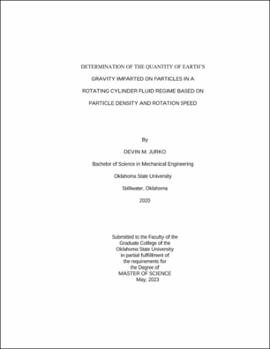| dc.contributor.advisor | Alexander, Aaron | |
| dc.contributor.author | Jurko, Devin M. | |
| dc.date.accessioned | 2023-08-25T20:06:10Z | |
| dc.date.available | 2023-08-25T20:06:10Z | |
| dc.date.issued | 2023-05 | |
| dc.identifier.uri | https://hdl.handle.net/11244/338930 | |
| dc.description.abstract | This research is an in-depth analysis of the movement of yeast -like particles in a Rotating Wall Vessel (RWV) using a series of computational fluid dynamic (CFD) simulations. The purpose of the RWV is to counteract the effects of gravity by reducing the internal and external effects that it has on particles in cultures, in this case spherically modeled simulated yeast cells. The internal effects can be characterized as the distortion of the internal structure due to density differences, whereas the external effect results from the deformations of the particle shape resulting from collisions with the RWV walls or other particles. The RWV counteracts both effects by continuously rotating the fluid regime containing the cellular particles, allowing for a constant state of particle suspension. Using CFD simulations, an RWV with yeast cells in the fluid regime was modeled to track the acceleration and movement of these particles at various locations within the unit. Our analyses found that depending on their location in the vessel, the particles experienced different accelerations. The particle acceleration was the smallest towards the center of the fluid regime where the particles were furthest away from the walls. Specifically, the particles experienced between 0 m/s² and .2 m/s², meaning that the RWV can successfully counteract 98-100% of the acceleration due to the gravity of Earth. This work creates a repeatable framework for the analysis of how cells move in a RWV to help understand the gravitational forces that the cells experience that may trigger certain biological responses. | |
| dc.format | application/pdf | |
| dc.language | en_US | |
| dc.rights | Copyright is held by the author who has granted the Oklahoma State University Library the non-exclusive right to share this material in its institutional repository. Contact Digital Library Services at lib-dls@okstate.edu or 405-744-9161 for the permission policy on the use, reproduction or distribution of this material. | |
| dc.title | Determination of the quantity of earth’s gravity imparted on particles in a rotating cylinder fluid regime based on particle density and rotation speed | |
| dc.contributor.committeeMember | Vora, Hitesh | |
| dc.contributor.committeeMember | Yang, Chulho | |
| osu.filename | Jurko_okstate_0664M_18147.pdf | |
| osu.accesstype | Open Access | |
| dc.type.genre | Thesis | |
| dc.type.material | Text | |
| dc.subject.keywords | biochemistry | |
| dc.subject.keywords | bioengineering | |
| dc.subject.keywords | computational fluid dynamics | |
| dc.subject.keywords | fluid mechanics | |
| dc.subject.keywords | microgravity | |
| dc.subject.keywords | rotating wall vessel | |
| thesis.degree.discipline | Mechanical and Aerospace Engineering | |
| thesis.degree.grantor | Oklahoma State University | |
